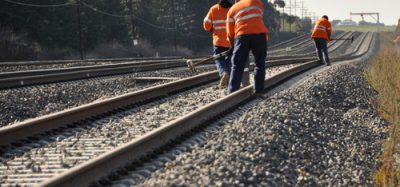Assessing infrastructure development
Posted: 31 May 2005 | | No comments yet
Austrian Federal Railways (Österreichische Bundesbahnen – ÖBB) has embarked to gradually complete Austria’s rail infrastructure, based on the requirements specified for the 2020 target network to enable it to cope with current and future transport demand. Capacity, cost efficiency and maximum customer benefit are the main drivers of all initiatives concerning operation, planning, construction and maintenance of infrastructure.
Austrian Federal Railways (Österreichische Bundesbahnen – ÖBB) has embarked to gradually complete Austria’s rail infrastructure, based on the requirements specified for the 2020 target network to enable it to cope with current and future transport demand. Capacity, cost efficiency and maximum customer benefit are the main drivers of all initiatives concerning operation, planning, construction and maintenance of infrastructure.
Austrian Federal Railways (Österreichische Bundesbahnen – ÖBB) has embarked to gradually complete Austria’s rail infrastructure, based on the requirements specified for the 2020 target network to enable it to cope with current and future transport demand. Capacity, cost efficiency and maximum customer benefit are the main drivers of all initiatives concerning operation, planning, construction and maintenance of infrastructure.
In the future, new assessment methods will help to give reasonable, retraceable and transparent answers to the difficult question of defining development project priorities. The goal is to better demonstrate the advantages and disadvantages of individual projects at an early stage, thus making a positive contribution to objective public discussions. ÖBB will capitalise on its new Group structure to quickly and efficiently proceed towards this goal.
New structures, new financing mechanisms
Based on its fundamental restructuring under one of the greatest change management processes ever experienced in history by an Austrian business, ÖBB has adopted a new corporate structure. Under the umbrella of a holding company, ÖBB Holding AG, nine subsidiary companies have been set up. One of the subsidiary companies is responsible for infrastructure development, another one for maintenance and management of operations. With these fundamental structural changes, the system of funding Austria’s rail infrastructure has also been completely changed. The previous transfer ordinances by which the Infrastructure Minister transferred specific infrastructure projects and their funding to ÖBB have been replaced by the so-called framework plan which is agreed for a period of six years and adapted every year. The information contained in the framework plans is prepared by ÖBB infrastructure experts whose proposal is submitted to the Infrastructure Ministry for approval. Following consultation in the policy-making bodies, an approved version is transmitted to ÖBB endowing it with both the legal and financial means to implement the projects.
Elimination of traffic impediments
To both infrastructure companies (ÖBB Betrieb AG and ÖBB Bau AG) and consequently also the transport operating companies (ÖBB Personenverkehr AG and ÖBB Rail Cargo Austria AG) the elimination of traffic impediments is a central motivation for infrastructure maintenance, reinvestment, development or construction initiatives. Taking into account the existing railway network as well as anticipated future transport flows, this task comprises, in particular, the following three main points:
- Elimination of capacity bottlenecks existing on routes and in junctions
- Enhancing the efficiency of production flows
- Consistent increase in safety levels to maintain the state-of-the-art
The goal is to provide infrastructure which meets the demands of the market and customers and which allows it to provide optimum quality and cost effectiveness of transport services. In this context, ÖBB attaches great importance to the targeted use of funds to achieve maximum benefit from projects delivering the greatest possible traffic effectiveness.
It is a fundamental requirement to eliminate weak points on the infrastructure and to prevent their future development. When analysing weak points, ÖBB differentiates between existing bottlenecks that are due to existing traffic or demand, and bottlenecks which will develop in the future due to forecasted increase in traffic volumes or demand. After all, the efficiency of the rail network is based on an operational program which applies to the entire network and contains the forecasts on future traffic volumes in both passenger and freight traffic.
The most important weak points which need to be eliminated include inadequate safety conditions, prevailing traffic impediments (such as capacity bottlenecks, transport restrictions, etc.), complex production flows (changing of engines, changing of gauge, etc.) and lacking compliance with quality criteria. Our investment, re-investment and maintenance initiatives are targeted to addressing these weak points.
Infrastructure investment strategy
Safety, a fundamental quality feature of the Austrian railway, is imperative when it comes to planning infrastructure investments. The construction of state-of-the-art electronic signal boxes has been in full swing for a period of ten years. Hundreds of outdated installations, some of which dated back to the 1950s, have been replaced by state-of-the-art technology. In addition to providing a significant rationalisation potential in the human resources sector, these new installations also considerably increase the quality of operations and optimise work flows and infrastructure capacity. The significant increase in safety thanks to the use of electronic signal boxes is a vital aspect which cannot be ignored.
In addition to the initiatives relating to the masterminds of rail traffic operation, ÖBB also focuses on:
- Providing access to platforms without having to cross rails
- Consistently implements new tunnel safety concepts
- Improves safety at level crossings (in particular by eliminating passive crossings and provision of actively protected crossings)
- Promotes new technologies for train control such as ETCS, a system already being applied in Austria under a pilot project
Apart from safety, the issue of streamlining and optimising operations is a crucial item on our agenda. The goal is to improve our commercial performance, to change over to remote control on lines where this is possible in order to further centralise operations, to elaborate uniform line characteristics, and to improve production flows by extensive automation. In the course of these initiatives, the infrastructure is consistently re-dimensioned where based on demand it is commercially no longer justifiable.
New assessment methods
At present, ÖBB is working intensively to develop a new method of representing lines and line sections to image infrastructure projects in a transparent and comprehensible way, so as to contribute to greater objectivity in public discussions about development and investment projects. To this end, ÖBB defined the following overriding goals:
- Profitability and rationalisation
- Quality
- Safety
- Economy and ecology
- Transport policy
Based on these fundamental requirements, which will be realised by implementing a set of individual measures, a new method of investment prioritisation – a new logic of prioritisation as it were – is developed. In this context, great importance is attached to achieving maximum benefit from projects delivering the greatest possible traffic effectiveness.
As well as increasing profitability which is an important requirement of operations management, offering high-level quality standards on the Austrian rail network is also a special concern of ÖBB. This involves, in particular, cuts in journey times to strengthen the competitiveness of rail versus road, reliability and punctuality, optimum availability, capacity improvements and improvements in customer service quality (in passenger service this involves, in particular, barrier-free access to platforms, platform information via loudspeakers, provision of electronic arrivals/departure boards at platforms, etc. In freight traffic this involves construction of private sidings, etc.). To ÖBB, quality of rail service is a basic requirement meeting of which is imperative in order to communicate the usefulness of infrastructure investments to the end customers of passenger and freight traffic. Thus, all considerations, planning and decisions are based on or deliberately establish a direct connection between infrastructure investments and benefit to the end customers.
In public discussions about infrastructure development, a very lively process in Austria involving numerous stakeholders, general political and economic aspects of infrastructure measures are rightly brought up and used for assessment. This particularly concerns the benefits of greater traffic safety for the national economy, or cuts in journey times, as well as economic, siting and labour market policy issues, which need to be taken into account in particular with a view to regional aspects, in addition to the general transport policy demand of making a contribution to efficient shifting of traffic from road to rail.
Planning tools
In order to be able to meet the complex requirements and at the same time to ensure the desired transparent representation of project proposals, ÖBB makes use of comprehensive, EDP-supported simulation tools. These tools allow optimised and demand-oriented development of infrastructure projects from an objective perspective, provide evidence for the necessity of a specific measure, and allow retracing the opinion forming process if a decision has to be taken in favour of one of several variants on hand. The EDP-supported planning tools used by ÖBB for tasks such as calculation of line capacities, operational simulations, network modelling, formulae for the calculation of platform edge height and distance from the track, or dimensioning traction energy supply live up to the latest state-of-the-art.
Present focal points of infrastructure development
The investment volumes for developing Austria’s rail infrastructure are subject to a clearly defined and limited budget line, which is reflected in the framework plans. Austria’s Infrastructure Master Plan, which was drawn up in 2001 by the Austrian Infrastructure Ministry together with experts from ÖBB and in agreement with the Austrian provinces, sets out a target network which, depending on the pace of implementation, is designed to be realised and completed by 2020. The target network includes all projects which are necessary, from today’s perspective, to complement and enlarge the existing rail network and its underlying infrastructure. Therefore, consideration has been given to the closing of gaps as well as future traffic developments based on which greater capacity demand may be anticipated.
From the viewpoint of ÖBB, priority should be given to promoting projects from which an increase in the infrastructure usage charge, that is additional revenues from the sale of train paths, may be anticipated, projects from which customers will benefit directly and at short notice and which will sustainably increase profitability and safety, and from which benefits will be derived as quickly as possible. The mandate and request to realise all projects set out in the Infrastructure Master Plan is, however, beyond doubt.
Austria’s Westbahn, the westbound trunk line linking Vienna and Salzburg, is among the priority development projects referred to above. On this line, which has a length of some 300km, ÖBB will offer a travelling time of two and a half hours on high-quality passenger trains. The current framework plan ensures that by about 2012 major parts of the project will be completed, thus delivering a massive capacity and quality increase for the mixed operation of passenger long-distance, passenger short-distance and freight trains.
The drive for developing eastern-bound infrastructure will also be essential for the future. With the enlargement of the EU, by which Austria has become a country which (except for its border with Switzerland) borders only EU countries, the course of economic development in the Central European countries has taken a completely new direction. One important consequence of the new economic conditions is the marked change in the development of demand for mobility. Since the fall of the Iron Curtain, cross-border transport between Austria and its eastern neighbours have multiplied, road being the transport mode that is most widely used, facing ever-increasing problems. Therefore, new solutions need to be identified and implemented as quickly as possible in both passenger and freight traffic in order to be able to meet the significant increase in demand by providing attractive, customer-oriented and efficient services.
An example where the urgent need for action is most obvious is the connection between the two capitals Vienna and Bratislava (Slovakia). The distance between these two cities is about 50km and high traffic volumes are recorded both on rail and on road. The two existing railway lines are only insufficiently developed, single-tracked and on some sections not electrified. Current plans also foresee that the airports of the two cities should be connected via rail. Vienna Airport is already connected to the rail network and its station is currently being modified to enable it to cope with long-distance trains. The connection to the airport of Bratislava is, however, still lacking. In intensive negotiations, ÖBB makes every effort possible to identify solutions to eliminate the infrastructural and technical obstacles which are still a prevailing feature of border-crossing rail traffic.
Other important points of the current development program include: the
- Semmering base tunnel on the Südbahn.
- Austria’s south-bound railway trunk line.
- Double-tracking of the Pottendorf line in Lower Austria (to deliver a marked reduction of the traffic burden in the catchment area of Vienna).
- Construction of the Koralm railway between Graz and Klagenfurt and the
- Construction of Vienna Main Station to replace today’s Vienna South Station as terminal station of the Südbahn and Ostbahn lines, thus allowing continuous operation of trains on all routes between north, south, west and east.
With the implementation of this ?420 million project, ÖBB will put an end to the historically grown situation of operating a terminus that is located at a key point – the operation of which is complex, a financial burden and not customer-friendly. The preparatory works for the construction of the station are already in full swing; work is scheduled to be completed by 2012.
Summary
ÖBB endeavors to capitalise on the benefits of its new Group structure and the optimised assignment of responsibilities and tasks. As well as strengthening its market-orientation in both passenger and freight traffic, it is also endeavoring to propose and implement reasonable, retraceable and transparent infrastructure projects. New assessment methods have been designed to provide a better line of reasoning for planned measures and to facilitate decision-making when it comes to defining priority development projects. Based on these tools, ÖBB endeavors to improve the understanding for development and funding needs and to implement the goals defined so as to deliver maximum benefit as quickly as possible.






